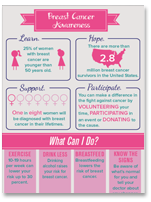Get Defensive About Breast Cancer
In the fight against breast cancer, early detection is the best defense. Know the risk factors, understand the symptoms and take the recommended steps for screening. Education is a powerful weapon, but it has to be accompanied by action.
How Important is Early Detection?
Breast cancer is diagnosed according to four stages. When it is detected early — before it has spread — the five-year survival rate is significantly higher.
| Stage of Breast Cancer | Five-Star Survival Rate |
| 1 | 100 percent |
| 2 | 93 percent |
| 3 | 72 percent |
| 4 | 22 percent |
Know Your Risks
Anyone can be affected by breast cancer, even men. But certain risk factors can increase your chances of developing the disease. If you are at a higher risk for breast cancer, talk to your doctor about developing a preventive care plan that’s right for you.
- Gender: Women are 100 times more likely to develop breast cancer than men. At some point, 1 in 8 women will be diagnosed with the disease.
- Age: The chances for developing breast cancer increase with age.
- Genetic factors: Inherited mutations like BRCA1 and BRCA2 can increase risk.
- Family history: Those with close relatives who have been diagnosed with breast cancer are at a higher risk.
- Personal history: Cancer in one breast increases the chance of cancer developing in the other breast, or in another part of the same breast.
- Menstrual periods. Women who started menstruating early (before age 12) and/or went through menopause later (after age 55) have a slightly higher risk.
- Obesity: Being overweight after menopause can increase risk.
Know the Symptoms
The most common symptom of breast cancer is a lump or mass — but it’s not the only sign. Other symptoms may include:
- Swelling of all or part of the breast
- Skin irritation or dimpling
- Breast or nipple pain
- Nipple retraction (turning inward)
- Redness, scaliness or thickening of the nipple or breast skin
- Nipple discharge (other than breast milk)
No Excuses — Schedule Your Screening
- Mammogram: Women ages 40 and older should have annual mammograms.
- Clinical breast exam (CBE): Women in their 20s and 30s should have a CBE as part of an annual checkup.
- Breast self-exam: Beginning in their 20s, women should do a monthly self-exam and report any changes to their doctors immediately.
Prevention and Progress
There are more than 2.8 million breast cancer survivors in the United States. When you have regular screenings and educate others about early detection, you are joining the overall fight against breast cancer.

